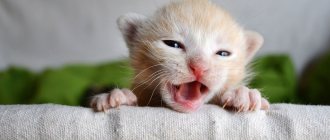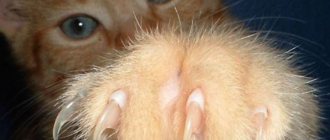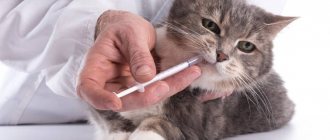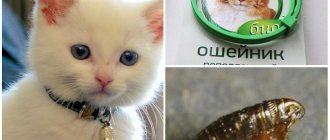7288Pavel
1
Cats, for the most part and regardless of age, are very playful and active animals. That is why many owners are perplexed and often ask the question: “until what age is a kitten considered a kitten?” It is difficult to give a definite answer to this question. Largely because this issue is individual for each cat.
In this article we will talk about the main stages of a kitten’s development, and we will also try to come to a conclusion when a kitten finally becomes an adult cat.
© instagram.com/juliaolimpian
Physical development and growth stages of a kitten
The process of a kitten becoming an adult cat can be divided into 3 stages. Each developmental milestone has certain characteristics of animal development:
- First stage of development (first month of life). The kittens are still very small and spend all their time with their mother cat. During this period of life, kittens develop immunity and their visual and auditory apparatus finally develops. Babies move slowly and uncertainly: they crawl rather than walk. At this time of life, it is important to provide kittens with peace. It is also necessary to ensure good nutrition for the nursing mother, since her body in the process of feeding her offspring needs an increased dose of nutrients.
- Second stage (2-6 months). At about 5-6 weeks of age, kittens are actively learning to walk and run. By this point, their basic systems of organs and senses are already fully formed. Kittens also begin active socialization: they constantly play, explore the outside world in every possible way and interact with it. This stage of development can rightly be considered the main one in the development of kittens, because by the time they are 6 months old, babies are practically no different from adult cats. At this age, it is extremely important to provide kittens with good nutrition, because the quality of skeletal formation will depend on this. Special food for kittens is best suited for babies, as they contain all the necessary vitamins and minerals for a growing body. Babies need to be fed 3-4 times a day.
- The third stage (6-8 months) is the period of puberty in cats. At this age, females may begin their first estrus, and males begin to mark their territory. Many believe that it is during this period that the cat becomes an adult. This opinion is partly true. Indeed, by the time they reach one year old, many kittens become full-fledged male cats.
However, do not forget that this issue is individual for each animal. Some animals become adults much later. This is especially true for domestic and sterilized cats. In such animals, final adulthood may occur much later.
In the first weeks of life, kittens grow and develop very quickly. Babies are born with their eyes and ears closed. They don’t know how to walk yet, they just crawl on their bellies, and they find their mother by smell.
By 2 weeks, kittens' eyes open.
By 3 weeks, the ear canals are completely open.
By 4 weeks, kittens can go to the toilet on their own (until this age, the process of urination and defecation is stimulated by their mother cat). Kittens are getting sharp baby teeth.
By 4 weeks, kittens venture a little further from their mother to explore the world around them, communicate and play with their brothers and sisters. At this age, babies are already beginning to show interest in what their mother eats, so they can gradually be switched to special food for kittens.
At 8-12 weeks, kittens receive their first vaccinations: now they are ready to leave their mother and move to a new home.
By 4 months, baby teeth begin to fall out, and molars grow in their place. At approximately 7 months, the kitten has lost all of its baby teeth.
At 5–6 months, the kitten enters puberty, which means it can already be castrated or sterilized. It is easy to determine this moment: the cat begins to meow loudly, rub against furniture, bend its tail to the side, and cats mark their territory and scream at night. If you have kittens of different sexes living at home, they need to be sterilized or resettled, because it is too early for cats to give birth at that age and it is dangerous to their health.
We suggest you read: Number of teeth a cat has
By 6 months, kittens look almost like adults, but they still require a suitable diet for growth and development: after all, cats only really mature at 12 months. We recommend giving your baby a specially developed balanced food for kittens, and after 12 months switching to food for adult cats.
It is believed that cats mature, that is, they are finally physically formed, at 1 year, but their muscles can strengthen up to 2–2.5 years. Much depends on the breed. For example, Bengal cats mature at 9 months, and males at 14–16 months. But Maine Coons are formed before they are 2 years old. The age of the kitten must be taken into account when preparing a diet or planning a sterilization period. Otherwise, your pet will always be happy with games and affection, no matter how old he is.
Causes of cat screams
At home, cats do not have the opportunity to mate freely and there is an accumulation of testosterone (male sex hormone), the excess of which leads to rutting - the cat yells at night, becomes aggressive, marks corners and desperately tries to find a cat to mate with, which is why it screams, not allowing peace for the owners.
If a cat and a cat live in the same apartment, have reached childbearing age and can mate, or the cat is spayed and the cat is neutered, and the night cries continue, then the owners should visit a veterinarian. Cat howls can be caused by hepatic or renal colic, which is accompanied by urolithiasis. The development of the disease is facilitated by an unbalanced diet, which results in the formation of stones in the genitourinary canals. And when an adult cat goes to the litter box to relieve itself, it feels a sharp cutting pain and begins to scream heart-rendingly.
The final maturation of the kitten
Many people are surprised by the fact that adult cats retain the same playfulness and curiosity as kittens. In fact, this is completely normal. Cats are very active and mobile animals, so it is not at all shameful for them to show playfulness and curiosity even at an advanced age. Such behavior for an animal is not at all a sign of insufficient maturity.
If you find or receive a kitten as a gift, you should find out its age. Kittens develop faster than humans, and a two-month-old kitten will look very different from a six-week-old kitten. Although it is impossible to know the exact age, an approximate figure will allow you to choose the right food and care for your kitten.
What are the main nutritional goals for adult cats?
The main goals of nutrition for adult cats are to improve health, longevity and quality of life.
The main goals of nutrition for adult cats are to improve health, longevity and quality of life. Nutritional needs at this stage of life are quite broad, as healthy adult cats can tolerate and compensate for significant variations in nutritional intake. An appropriate nutrient mix should take into account common health problems that may arise from nutrition, including dental disease, obesity, feline lower urinary tract disease, cancer and osteoarthritis.
Optimal age to move
Every owner should know how old his pet is. It's easy to see the difference in what a 1 month or 1 week kitten looks like in appearance. It develops at a rapid pace, at each specific stage there are characteristic signs that indicate an approximate date (only a veterinarian can say for sure).
- size;
- teeth;
- eye color;
- appearance;
- behavior.
Kittens are often purchased through online advertisements. Thoroughbreds are offered starting from 3 months of age. There are often offers to adopt 5-7 month old kittens. Pseudo-pedigree animals without documents of origin are sold as early as 3-4 weeks of age. Kittens from 3 weeks old are placed in “good hands” for free. Usually these are kittens from domestic and outdoor cats whose owners for some reason did not neuter.
At what age is it better to take a kitten home is an important question. Professional breeders claim that at 3-4 months the kitten is completely independent of the cat: it licks itself clean, knows the litter box, uses a scratching post following the example of its mother, eats and plays independently. The main thing is that the cat no longer feeds the kitten with her milk.
The baby, previously separated from his mother, suffers without her milk. It is difficult for him to digest industrial feed or natural food, which can lead to vomiting, diarrhea, and refusal to eat. He doesn't know how to lick himself or wash his paws. Because of this, his eyes may become sour and respiratory diseases often occur. Such a kitten is still poorly oriented in space and is not able to use the tray - it simply does not remember where it is.
At older ages, kittens are usually taken from breeders. These kittens attend exhibitions from 10 weeks, receive diplomas and are prepared for an exhibition career and breeding. The cost of an exhibition animal is much higher than the price of a kitten without diplomas and titles. A kitten that is unsuitable for exhibitions and breeding is usually already neutered at this age, and breeders sell it for a low price.
We suggest you read: How to make an aquarium with your own hands at home.
Cat to human age ratio
There are no significant developmental leaps in growing and adult animals. This makes it easier to correlate the age of a cat and a person.
In this table we have shown what one year of life of a cat or male cat is equal to at the stages of adolescence, youth, maturity and old age per human age.
| Age of the cat | Person's age |
| 1 year | 18 years |
| 2 years | 20 years |
| 3 years | 25 years |
| 4 years | 30 years |
| 5 years | 35 years |
| 6 years | 40 years |
| 7 years | 45 years |
| 8 years | 50 years |
| 9 years | 55 years |
| 10 years | 60 years |
| 11 years | 64 years old |
| 12 years | 68 years old |
| 13 years | 72 years old |
| 14 years | 76 years old |
| 15 years | 80 years old |
| 16 years | 84 years old |
| 17 years | 88 years old |
| 18 years | 92 years old |
| 19 years | 96 years old |
| 20 years | 100 years |
Choosing a cat
In addition to personality traits, it is important that the cat is clinically healthy, vaccinated and sterilized. In some cases, people take home quite elderly pets or even those with chronic illnesses from the shelter. In such situations, it is important to clearly understand what kind of disease we are talking about and what consequences and expenses this may lead to.
In a shelter environment, it is difficult to understand the character of a cat. If she comes up to people and allows herself to be petted, most likely she is quite socially adjusted. On the other hand, a cat may be very frightened and even aggressive at the first meeting, but this does not mean that it will remain so in the future.
It is important to talk with the service staff about the habits and characteristics of the chosen animal, and also describe your conditions (other animals, children, small apartment). Some cats, for example, will do well with a dog, but will not get along well with children, which can lead to behavior or cleanliness problems.
Choosing the right pet, taking into account all the features of the new family, is the best prevention of animals returning to the shelter. If you want to get advice from those who have already adopted an adult cat at home, go to the relevant forum. “I wanted to adopt an adult cat, I need advice,” this is how your message may begin.
You can also ask who to take, and where is the best place to take a cat, they will definitely tell you what to do and give you a lot of advice. If you are not ready to go to a shelter for a cat, try advertising on specialized websites on the Internet or on your page in social networks. You can write, for example, “I’m taking an adult cat into the house, is someone giving the cat into good hands?” As a rule, it is difficult to adopt such cats, so people will probably respond willingly.
Ways to Prevent Cat Crying
If the cat is healthy and lives alone in the apartment, then you can prevent cat screams by following the advice of experienced breeders:
- castrate your pet - in the absence of testicles, testosterone is not produced, which means there is no sexual desire;
- breed a cat with a cat;
- give your pet more physical activity;
- not allowing you to sleep during the day - this suppresses the instincts of a nocturnal predator;
- arrange active games with the cat so that he sleeps at night like a baby;
- monitor your pet’s diet - the cat should receive selected foods and meat so as not to feel a deficiency of nutrients. The mustachioed man begins to become lazy, and his hunting instincts become dull.
Some cats are talking breeds and will demand communication. You should not ignore such conversations, and then the animal will be calmer and more satisfied. If the option of obtaining offspring is being considered, then you should get a mate for your pet. A cat and a cat in the same apartment will not let each other get bored and will save the owner from heart-rending screams during the festivities.
If reproduction is not part of the owner’s plans, then you need to think about castration.
How kittens grow
The surest way to determine the age of a kitten is by observing it. There are certain periods of development of an organism that indicate the date of its birth. The older the pet, the more difficult it is to know exactly how old he is. The easiest way to do this is before 1 month, when the main stages of the formation of all animal body systems occur:
- the umbilical cord disappears;
- the baby begins to stand on his feet;
- body weight increases;
- eyes open, their color changes;
- teeth appear and grow.
Slow growth of cats - some reasons
You can often observe that cats belonging to the same breed have completely different appearances. Due to their slow growth, some kittens may be smaller than their peers. There are many reasons that can lead to this.
To prevent such a problem, it is necessary to regularly consult a veterinarian and give the cat anthelmintics.
Hormonal disbalance
The consequence of a hormonal imbalance can be a slowdown in the development of the cat’s body for some time, and then it suddenly begins to grow.
This especially applies to cats that have undergone castration.
Conditions and habitat
These factors are very important for the development and growth of pets. If you compare domestic cats and their street relatives, the latter clearly lose. Due to a lack of essential vitamins, they have weak immunity, which greatly affects their growth, and this is immediately noticeable.
If you decide to adopt a kitten from the street, do not rush to immediately stuff it with goodies and switch it to dry food. The best solution would be to add vitamins to the animal’s diet, which will allow it to quickly catch up with its peers in growth.
Adaptation of a cat to the house
So, you took an adult cat into your home. What problems might there be? First of all, this is toilet training. In the first days, limit your pet's movements around the house to one room or area - this will make it easier for her to understand where the tray is, and it will be easier for you to make sure that the cat has not organized a secret toilet under your bed.
It is advisable that in the room allocated for the cat there are no too secluded places, otherwise the frightened animal may hide under the sofa and spend several days there. At the same time, the process of pulling him out from under the sofa clearly will not lay a good foundation for a trusting relationship. Don’t rush with bathing, let the new tenant get used to you.
Try not to have noisy parties or general cleaning. You should also not go on vacation during this period and leave your new cat in the care of your neighbors. If your pet is afraid of someone and spends all its time in hiding, try to stay more in its field of vision while doing your usual things, but do not insist on contact (do not pick up the cat or forcefully stroke it).
Reasons for slow growth
It often happens that kittens of the same breed look different. Due to slow growth, some individuals may be smaller than their peers, and there are many reasons for this problem.
https://youtu.be/wARj0zg11D8
To avoid such a problem, you should visit the veterinarian more often and give the cat anthelmintic drugs.
Hormonal imbalances
Hormonal imbalances can slow down the development of the cat’s body, and after some time the pet will begin to grow rapidly. This is especially true for castrated males.
Living conditions and habitat
All this is very important for the growth and development of pets. Outdoor cats are very inferior in comparison to those that live in the house. Due to a deficiency of essential vitamins, their immunity is weakened, this affects growth and immediately becomes noticeable.
If you adopted a kitten from the street, you do not need to immediately offer it treats and switch it to dry food. The best option is to fill the cat’s menu with vitamins that will help him grow taller.
Kitten development by week
| Age (weeks) | External manifestations |
| There is an umbilical cord, eyes and ears are closed tightly. | |
| The eyes open. | |
| Ears rise, eyes are completely open. | Small but sharp anterior ones emerge. |
| The baby becomes playful and explores the environment | Long fangs appear next to the front ones. |
| Stands steady on his feet | Milk teeth appear behind the fangs and on the sides of the jaw. |
| High traffic activity. | |
| The cat eats and washes itself. | All baby teeth have appeared. |
| Normal weight for an adult of the breed. | Molar incisors appear. |
| 4-6 months | The distant molars and canines are erupting. |
| 7 months | The indigenous ones have completely cut through everything. |
We suggest you read: How to inject cats with oxytocin
What nutrients does my cat need?
Water is the most important basis of nutrition, but exact water requirements cannot be determined because cats' water consumption varies greatly depending on activity and environment and what kind of food they eat (dry or canned). If cats produce a lot of concentrated urine, there is a risk of lower urinary tract disease, so it is very advisable to increase the amount of water consumed. Many cats are more willing to drink running water, so you can build a fountain for your animal with a circulation pump and filter. Be sure to regularly clean fountains and change the filter according to manufacturers' recommendations.
While it is important to stick to the minimum, there is no benefit in overfeeding protein as the excess will be stored as fat.
Protein is an essential nutrient for adult cats. Nutrient comparisons must be made on a dry matter basis to achieve accurate results. The recommended minimum protein intake for adult cats is 20-26% protein. While it is important to stick to the minimum, there is no benefit in overfeeding protein as the excess will be stored as fat. In addition, excess protein intake over a long period may contribute to the progression of early kidney disease. Cats are carnivores, which means that the protein they eat must be of animal origin, so a vegetarian diet is not suitable. In general, sticking to a protein content of 30% to 40% is appropriate for any adult cat, whether an active cat or a sedentary cat.
As for fats, the cat’s lifestyle is of direct importance. A sedentary cat should consume 9-17% fat, while active cats should consume 10-30% fat. The fiber content can provide a feeling of fullness. For inactive cats, the whole fiber content should be at least 5-15%, while active cats need less than 5%.
A set of nutrients compiled through a series of tests may be much healthier than one compiled based on recommendations. Self-prepared diets are usually not balanced and should be avoided. Cat food packages include the manufacturer's contact information that you can use to request nutritional content data.
So when is the best time to adopt a kitten?
You can bring a cat child into a new home when he is ready to live without his mother. Here are the signs of his independence:
- He was at least 3 months old.
- He no longer suckles the cat's milk.
- Knows the litter tray and scratching post.
- Licks and washes itself.
- He eats well, is well-fed, and his weight is within normal limits.
- He is not afraid of a person, shows curiosity and interest in him.
- He received his first vaccinations and developed immunity under familiar conditions.
What signs does a veterinarian use to determine the age of an animal?
A veterinarian can quickly and accurately determine the age of any animal. If you need to find out the age of a cat, a specialist examines the four-legged patient, paying attention to the following parameters:
- Wool. In kittens it is silky and soft, and very rarely gets tangled. The abundant undercoat, similar to fluff, can be easily felt. If bald spots are visible, it means the baby is sick. With age, the coat becomes tougher and thicker.
- Lens of the eye. The doctor finds out its size and condition.
- Muscles and bones of the skeleton. At a young age, muscle mass is small, and bones are not yet strong enough.
- Claws . Almost transparent and not hardened in kittens, they become harder with age and acquire a milky tint.
- Teeth. Examining the teeth, the doctor determines their number and degree of wear.
There are many ways to determine the exact age of kittens, many of which can be used by anyone. With visual methods of determination, the error may be 1–2 weeks. If the detected signs are confusing and the conclusions drawn are puzzling, it is better to contact a veterinarian. The doctor will determine possible developmental delays, conduct a thorough examination of the animal and give an accurate answer and recommendations for caring for the baby.











